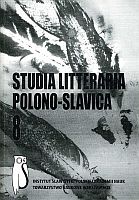Granice figuratywności w literaturze o Zagładzie
Limits of Figurativeness in Holocaust Literature
Author(s): Tomasz ŁysakSubject(s): Literary Texts
Published by: Instytut Slawistyki Polskiej Akademii Nauk
Summary/Abstract: Scholarship on Holocaust literature is focused around a crucial binary opposition literal/figurative in which the first part is deemed more suitable for tackling the topic. Proponents of documentary writing reject employment of metaphor and other tropes found in literary treatment of the Holocaust. However, historical narrativists such as Hayden White argue that all historical writing is rife with textual tropes. Such a stance stands in contradistinction to proscriptive position taken by Berel Lang who refuses to grant credibility to literature in the representation of the Shoah. I also examine the notion of limits of figurativeness as reflective of limits of language. On the other hand, the notion of limits is applicable retrospectively, i.e. we learn about them after their transgression. Moreover, as I try to prove, reliance on unsophisticated language is no protection against metaphor as it can be inferred from cognitive treatment of language by George Lakoff and Mark Johnson. I try to examine the limits of application of the experiential use of metaphor in relation to the reality of genocide especially with reference to Elie Wiesel’s Night. Other literary examples examined here are: Art Spiegelman’s Maus, with its blending the figurative with the documentary, and Martin Amis’ Time’s Arrow, in which a scrupulously exercised conceit of telling the story in reverse order enhances the representational qualities of the novel.
Journal: Studia Litteraria Polono-Slavica
- Issue Year: 2008
- Issue No: 8
- Page Range: 265-276
- Page Count: 12
- Language: Polish

